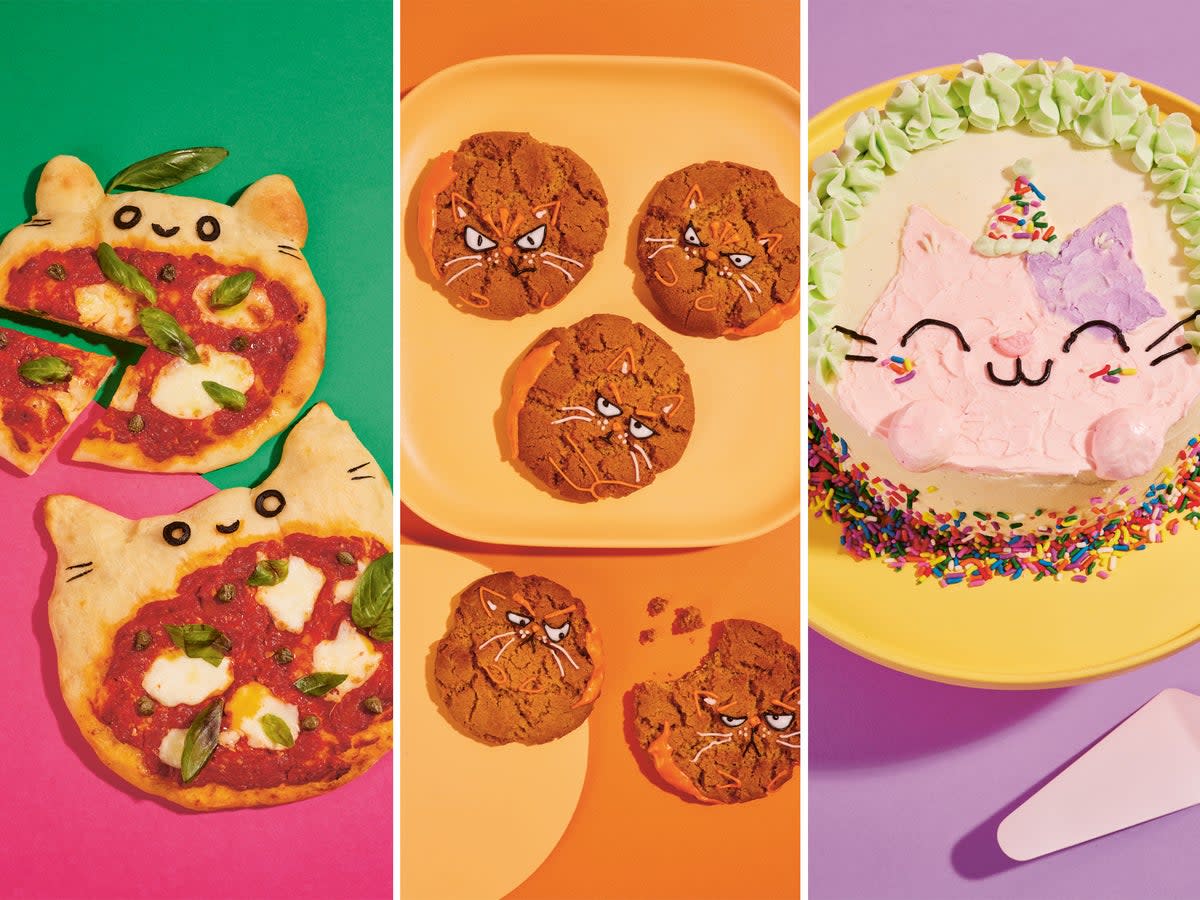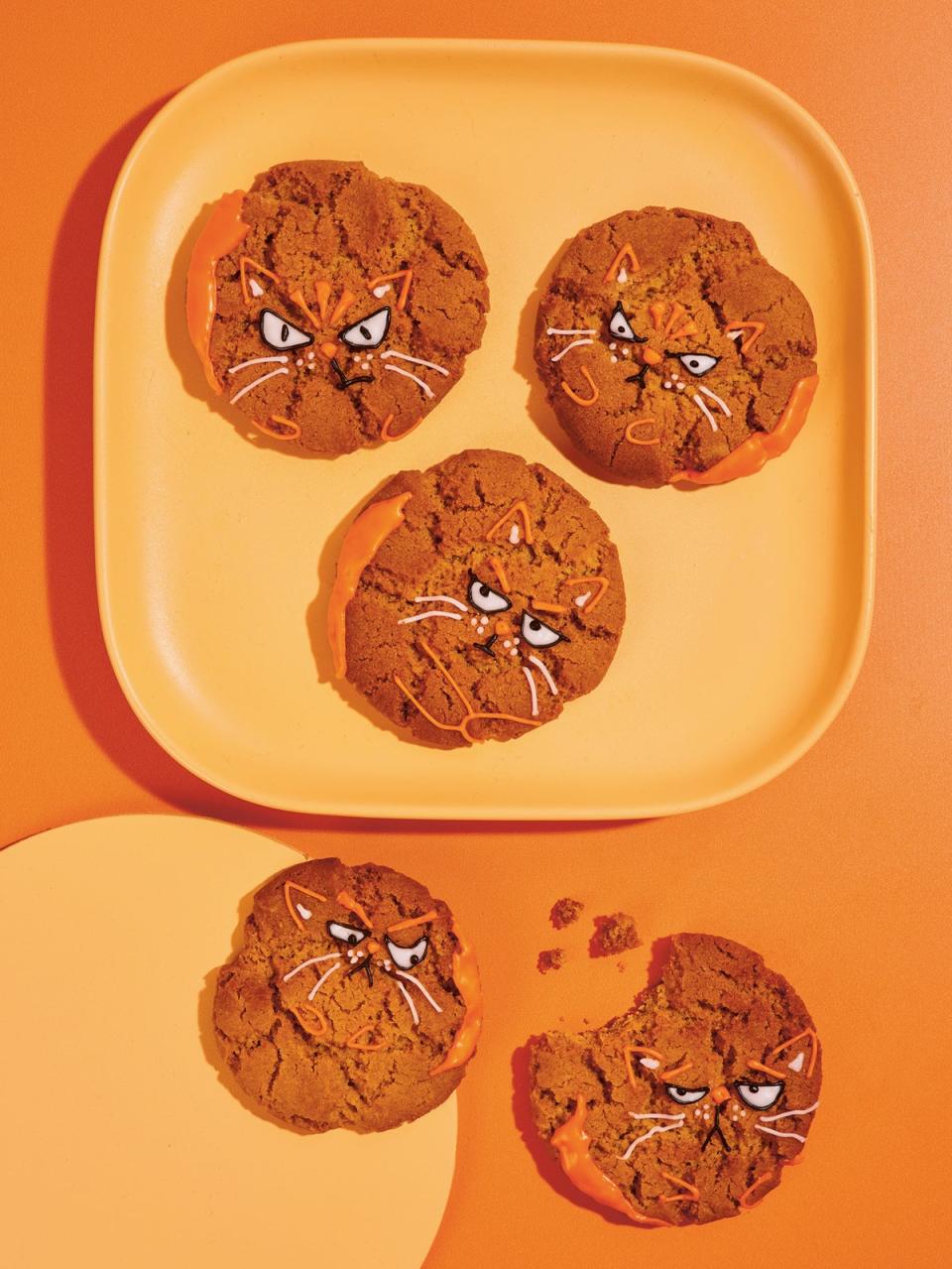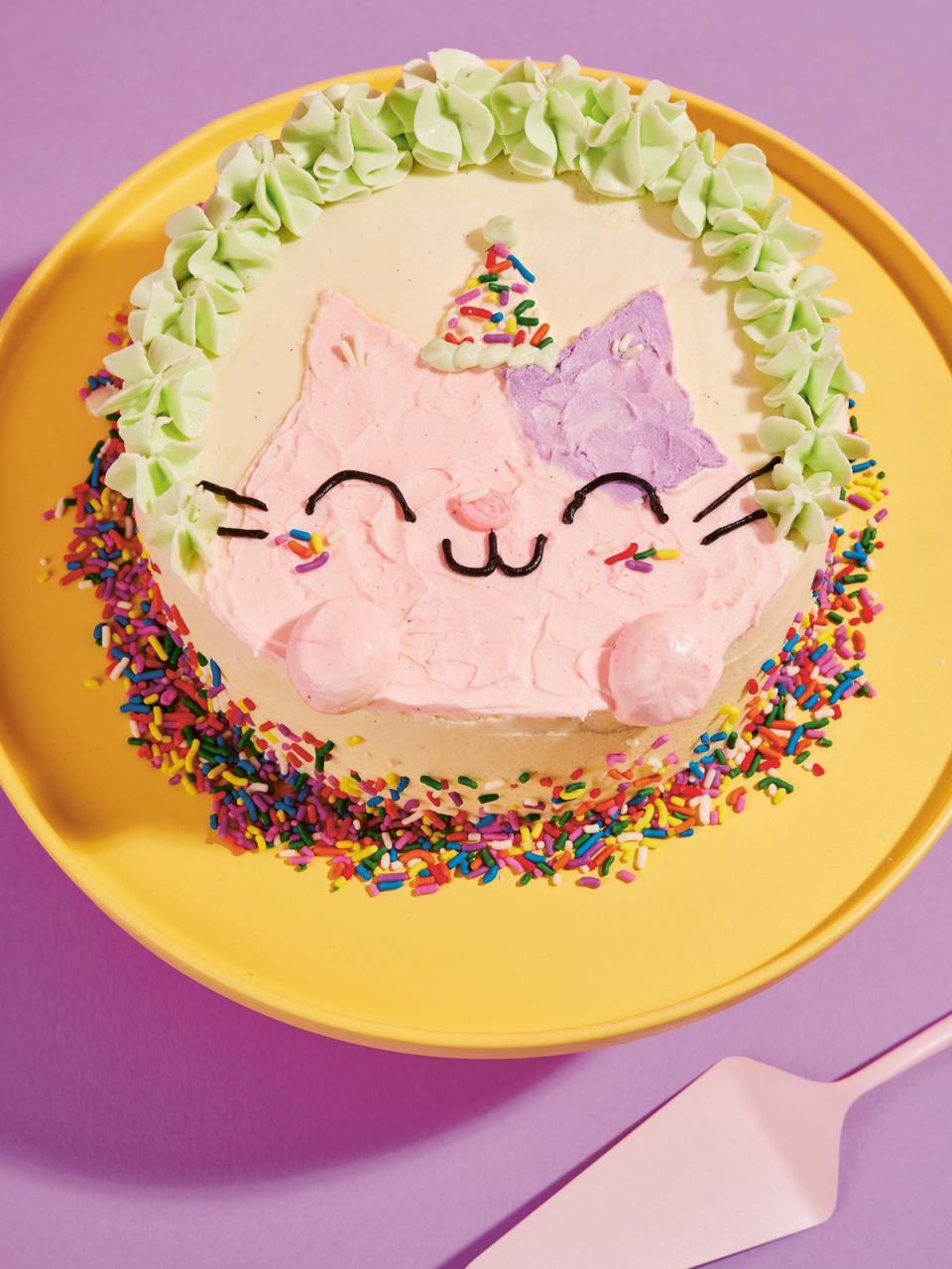Yes, there’s a cat-themed cookbook – here’s three recipes

Fat cat pizzas
“The cutest and chonkiest fat cat in its spiritual food form”, is how former Bake Off star Kim-Joy describes these pizzas – for the uninitiated, ‘chonky’ refers to animals that are delightfully pudgy.
“Get all your friends and family involved in decorating their own with their favourite toppings, then just enjoy the beauty of wholesome homemade (cat) pizzas!”
Makes: 3 small pizzas
Ingredients:
For the dough:
400g strong white flour, plus extra for dusting
2 tsp salt
7g instant fast-action dried yeast
280ml water (use tepid water to speed up the rise if you’re in a rush, but this isn’t necessary)
20ml olive oil, plus extra for oiling
Semolina flour for underneath the pizza (optional, but gives extra crunch)
For the toppings:
Around 10 tbsp tomato sauce for pizza (see below)
1 tbsp capers
200g mozzarella (drained weight)
A couple of black olives, for the cat face
Black gel food dye, mixed with a tiny amount of water, for painting cat whiskers
Handful of fresh basil
Salt and freshly ground black pepper
Extra olive oil, for drizzling
For the tomato sauce:
2 tbsp olive oil
2 cloves of garlic, finely chopped
2 tbsp concentrated tomato purée
1 x 400g can chopped tomatoes
Italian seasoning, to taste
Salt and pepper
Method:
1. To make the tomato sauce, place a saucepan over a medium heat, then add the olive oil and garlic. Fry for 20-30 seconds until lightly golden (but not brown). Add the tomato purée and fry for 30 seconds. Add the chopped tomatoes and a couple of pinches of Italian seasoning then simmer over a medium heat, stirring occasionally. After five to 10 minutes, the sauce should have reduced down and thickened. Season with salt and pepper to taste. Transfer to a bowl, cover with plastic wrap and chill in the fridge until ready to use.
2. To make the dough, place the flour, salt and yeast together in a stand mixer fitted with a dough hook attachment (you can also use a bread machine just to knead). Make sure that the salt is not directly touching the yeast. Stir together, then pour in the water and olive oil.
Tip: If you don’t have a machine for mixing the dough, or you have the time and want improved flavour and no need to knead, then simply mix all the ingredients together in a large bowl, cover with plastic wrap and leave the dough to rise overnight in the fridge until doubled in size. The second rise after shaping will take a little longer, as the dough will still be cold from the fridge, but remember that the colder and slower the rise, the better the final fat cat pizza will be!
3. Place the dough in a lightly oiled large bowl, cover with oiled plastic wrap and leave to rise for about one hour or so (this depends on the ambient temperature – if the room is warmer, it will rise faster), or until doubled in size.
4. Meanwhile, prepare the toppings for your pizza. At least 30 minutes before the dough is ready, preheat your oven to its maximum temperature to start preheating a baking steel, stone or simply a standard flat baking sheet (ideally one without a lip, for ease). Doing so will give your pizza a crispier base.
5. When the dough has risen, set aside a little for the ears, then divide the remaining dough into three equal pieces, placing each piece onto an individual sheet of baking paper (scatter semolina on the paper first, if you like, to add extra crunch). Use the heel of your hand to press each piece into a rough circle, then stretch the dough with your hand to thin it out, making the edges thicker than the middle. Use the reserved dough to add ears, pressing them very well to make sure they stick on.
6. Add your toppings to the dough, leaving space at the top for the cat face. Add sliced black olives for the eyes and mouth.
7. Leave the pizzas to prove at room temperature for about 20 minutes, or until puffed up slightly. They shouldn’t increase much in size. If you did an overnight first rise, then just wait for the dough to come to room temperature (up to two hours) before you bake it.
8. Once risen, slide any flat tray (or even a piece of stiff cardboard) under one of the pizzas – this should be easy to do, as the pizza should be on a sheet of baking paper. Slide the pizza along with the baking paper onto the preheated stone, steel or baking sheet that’s in the oven. If you’re not using a heated tray, simply place the tray of pizza in the oven as normal.
9. Bake one pizza at a time, for around five to 12 minutes each. The hotter your oven and the hotter the baking stone or steel, the quicker they will bake!
10. Once cooked, quickly paint the whiskers using black food dye mixed with a tiny amount of water and a paintbrush, then season with pepper, scatter with fresh basil (depending on your chosen toppings) and drizzle with extra olive oil. Serve straight away.
Ginger snap cats

“These are exactly how grumpy ginger tom cats would be personified in cookie form.”
“These little guys look fierce, but that fierceness belies a crisp and addictive cookie, with a fiery ginger heat that warms your belly.”
Makes: 16
Ingredients:
For the cookie dough:
150g self-raising flour (to make gluten-free, substitute with a gluten-free self-raising flour blend, plus ¾ tsp xanthan gum)
1¼ tsp bicarbonate of soda
2½ tsp ground ginger
70g caster or granulated sugar
¼ tsp salt
75g unsalted butter, melted (or vegan butter – use one that’s close to 80% fat content)
3 tbsp golden syrup
For the royal icing:
1 medium egg white (or 30-40g aquafaba or pasteurised egg white)
180-240g icing sugar
Orange and black gel food dyes
Note: You only need to make half the quantity of royal icing, as it’s hard to make a much smaller quantity and divide it up to create different colours. Any leftover icing can be piped out onto baking paper in long thin strands and left to dry. Once dry, chop up – and you have made sprinkles! Store these in an airtight jar.
Method:
1. Line two large baking sheets with baking paper.
2. Add the flour (plus xanthan gum, if gluten-free), bicarbonate of soda, ginger, sugar and salt to a large bowl, and stir until combined.
3. Pour in the melted butter, add the golden syrup and stir until the mixture forms a soft dough.
4. Roll the dough into a 25-cm long log shape, then cut into 16 equal pieces. Roll each piece into a ball and place on the prepared baking sheets, spaced at least 5cm apart. Flatten each ball slightly with the back of a spoon – they will spread during baking. Chill in the fridge for at least 30 minutes, or in the freezer for 10 minutes. Meanwhile, preheat the oven to 170C/gas mark 3.
5. Bake for 12-15 minutes until cracked on top and deep golden in colour. Leave on the baking sheets for 10 minutes to firm up, then carefully transfer to a wire rack to finish cooling.
6. While the biscuits cool, make the royal icing. Whisk the egg white (or aquafaba) with 180g of the icing sugar together in a large bowl until smooth, then gradually keep adding icing sugar and whisking to combine until the consistency is thick enough to pipe. If you lift a spoon out and drizzle over the top, the trail should hold for about 15 seconds before disappearing.
7. Leave a third of the icing white, then divide the remaining icing between two bowls. Dye one portion orange and the other black using gel food dyes. Transfer the different icing colours to piping bags, cutting a small tip in each. Pipe angry ginger tom cat faces onto each cookie and vary your designs, so that each cat is quirky and unique. Store in an airtight container for one to two weeks.
Happy purrthday cake

“This cake is full of warming ginger, sweet and salty caramel, and addictive Biscoff – a combination that both kids and adults won’t be able to resist.”
“The decoration on top is like doing a simple oil painting, but in buttercream that you can eat – and remember that asymmetrical faces are all part of the charm, so there’s no need to be too exact.”
Serves: 10-12
Ingredients:
For the spiced ginger cake:
Softened butter, for greasing
360ml milk (or plant-based milk)
2 tsp white wine vinegar
40g (2 tbsp) black treacle
150ml sunflower oil (or other neutral-tasting oil)
½ tsp salt
½ tbsp vanilla bean paste
330g self-raising flour (to make gluten-free, substitute with a gluten-free self-raising flour blend that contains added xanthan gum, plus ½ tsp xanthan gum)
55g caster or granulated sugar
250g soft dark brown sugar (or muscovado)
1 tbsp baking powder (or use gluten-free baking powder)
2½ tbsp ground ginger
¾ tbsp ground cinnamon
For the caramel:
25ml water
80g caster or granulated sugar
40g coconut cream (use just the thick part on top)
10g butter
Pinch of salt, to taste
For the buttercream:
250g butter, at room temperature, cubed (or vegan butter – use one that’s close to 80% fat content)
500g icing sugar
A little milk or plant-based milk
1 tbsp vanilla bean paste
100g Biscoff spread (this is added to a third of the buttercream; omit this if making the recipe gluten-free)
Your choice of sprinkles and gel food dyes
Method:
1. Preheat the oven to 170C/gas mark 3. Grease the bases and sides of two 18cm cake tins with butter and line with a circle of baking paper.
2. Add the milk and white wine vinegar to a large bowl and whisk together. Add the treacle, oil, salt and vanilla, then whisk again until combined.
3. In a separate large bowl, combine the self-raising flour (plus xanthan gum, if gluten-free), caster sugar, dark brown sugar, baking powder, ginger and cinnamon. Add the wet ingredients to the dry ingredients and whisk until just combined. Divide straight away between the two prepared tins and bake for 30-35 minutes (don’t open the oven in the middle of baking as it may sink), until springy on top and a knife inserted into the centre comes out clean. Leave the cakes in their tins for five minutes, then carefully run a knife around the edges and turn out onto wire racks. Peel off the baking paper and leave to cool completely.
4. Meanwhile, make the caramel. Add the water and caster sugar to a saucepan and swirl the pan to make sure all the sugar is hydrated with the water. Once the mixture starts to bubble (do not stir at all, otherwise the sugar will crystallise), increase the heat and wait until the sugar turns an amber colour. You can swill the pan around to even out the colour towards the end. Add the coconut cream to a small separate bowl. When the sugar syrup has turned a deep amber colour, remove the pan from the heat and add all the coconut cream in one go. Stir constantly with a balloon whisk. The sauce will bubble up, so be careful at this stage. Continue stirring until it is a smooth and creamy sauce. Add the butter and stir until dissolved. Pour the sauce into a medium bowl and sprinkle with a little salt to taste. Cover with plastic wrap and chill in the fridge for around 30 minutes. It will thicken as it cools.
5. Next, make the buttercream. Add the butter and icing sugar to a large bowl and beat with a handheld electric whisk until pale and fluffy (or use a stand mixer fitted with a balloon whisk attachment). Add a little milk to make the consistency easier to spread. Transfer 150g of buttercream to a separate bowl and whisk in the Biscoff spread. The Biscoff can stiffen the buttercream, so you can add an additional two teaspoons of milk to make it easier to spread. Then add the vanilla to the remaining (larger amount of) buttercream, plus a little milk again to help with the consistency.
6. Once the cakes are completely cool, level the tops with a serrated knife. To assemble, place the first cake layer on a flat serving board, spread the Biscoff buttercream on top (making it thicker at the sides than the centre), drizzle the caramel in the centre and place the second cake layer on top. Spread the vanilla buttercream in a thin layer over the top and sides to ‘crumb coat’. As this is the first coat, it doesn’t need to be extremely neat, and you will see crumbs coming through.
7. Chill the cake in the fridge for at least one hour, or in the freezer for 10 minutes until the buttercream is chilled and firm. Then cover the whole cake in another layer of vanilla buttercream to cover most of the crumbs. Use a palette knife (heating it under hot water for a smoother finish) to smooth the buttercream around the sides, then smooth the buttercream on the top, smoothing it in from the edges and towards the centre. (Make sure there is a little vanilla buttercream left for the decorations). Scatter sprinkles all along the bottom of the cake, then chill in the fridge for at least one hour again, or in the freezer for 10 minutes until the buttercream is firm.
8. Meanwhile, divide the remaining vanilla buttercream between different bowls and add food dye to colour as desired. You will need one colour for the piped swirls and your colours for the cat design (black for the face features, and one colour to contrast).
9. When the cake is chilled, use a cocktail stick to mark out your cat outline. Use a palette knife to spread buttercream within the outlines for the cat face. Chill the cake again in the fridge or freezer, then pipe the facial details on top. Place the black buttercream in a piping bag and cut a small tip then pipe the facial features to finish. You can customise this however you like; pipe extras, like a decorative border or a party hat, and sprinkles work a treat! Store in an airtight container in the fridge for up to a week, or three days at room temperature.
‘Bake Me A Cat’ by Kim-Joy (published by Quadrille, £16.99; photography by Ellis Parrinder).


